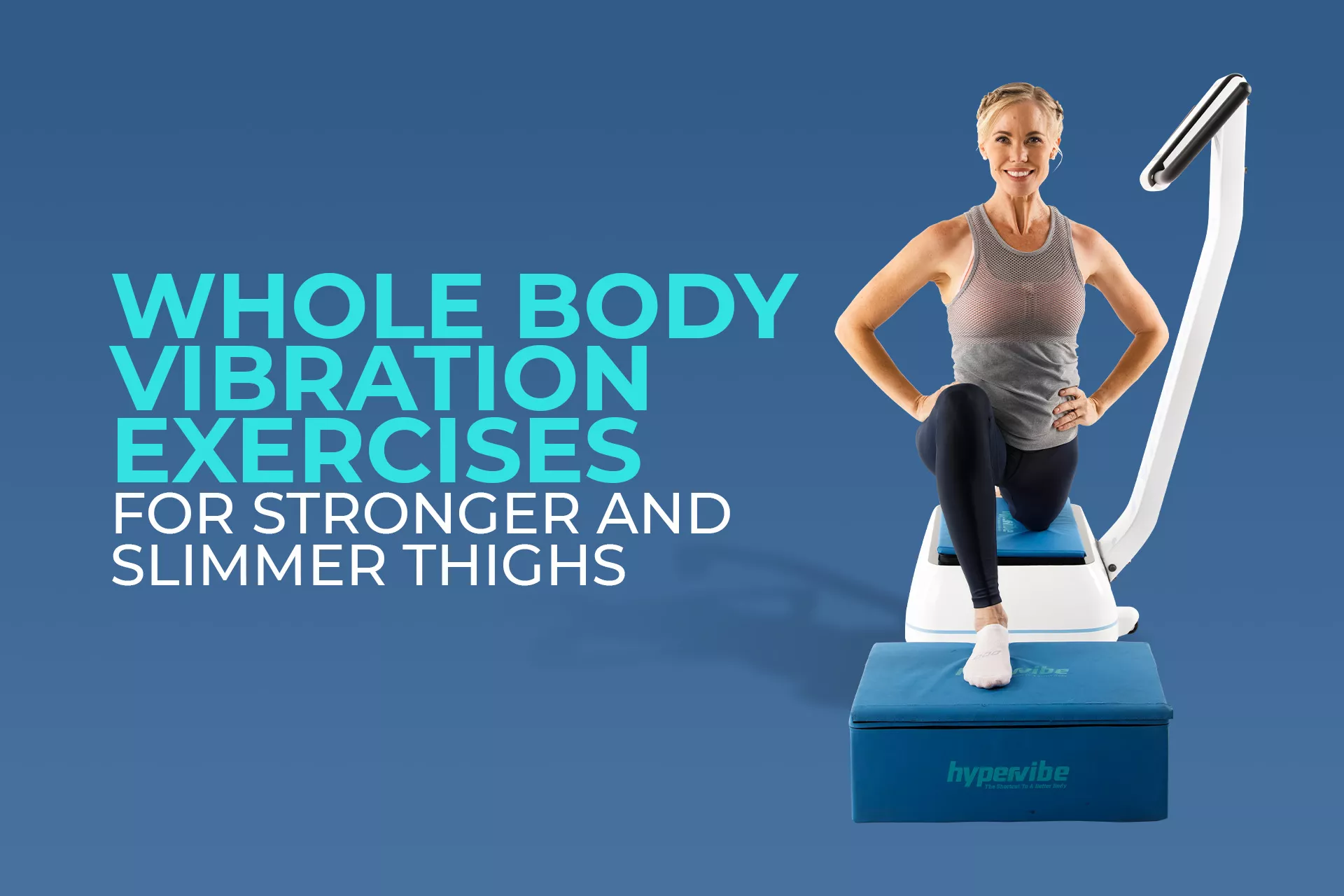
Can a Vibration Plate (Whole Body Vibration, WBV) really help slim and tone your thighs?
Yes, it can.
The vibration from WBV plates provides high levels of resistance, causing your thigh muscles to contract rapidly.
This boosts muscle activation (increasing muscle tone), circulation, and muscle strength.
However, spot reduction is a myth! You won’t burn fat from your thighs alone.
You need to lose overall fat for visible slimming and toning in your thighs to occur.
Your thigh-slimming program should include vibration exercises paired with regular cardio, a balanced, muscle-building diet, and overall calorie control.
And while all four may seem complicated to achieve, they are possible with a solid plan—and that’s precisely what this guide is for.
Inside you’ll find:
A vibration platform is designed so that, as the plate pushes up into your body, its forces mimic hypergravity conditions—a multiple of Earth’s normal gravitational force. Just like adding weights, higher gravitational loading (measured in G-force) creates greater resistance for your muscles.
As above, each upward motion of the platform places a force on your body, causing a rapid stretch to your muscles.
Then, the muscles reflexively contract.
This is similar to when a doctor hits your knee with a reflex hammer.
As you adjust the machine settings, the force of the contraction increases.
This is how Vibration Training increases muscle strength and bone density and can help burn fat.
In addition, it helps support your lymphatic and circulatory system health, which work based on gravity.
Research has shown that Vibration Training may increase growth hormone and testosterone levels. It can also influence cortisol levels beneficially. These effects, which won’t bulk you up, can be linked to strength improvements, as well as overall improvements in health and wellness.
Many people start Vibration Plate exercises for the thighs, hoping to both slim and sculpt the area.
However, toning and fat loss are not necessarily the same thing.
Toning in the thighs occurs when your muscles become firmer through consistent training, such as:
These moves engage large muscle groups, boosting strength and definition.
When these exercises are done on a Vibration Plate, it increases resistance for your muscles and builds strength.
Fat loss requires burning more calories than you consume.
A Vibration Plate can support this process by increasing muscle activity and calorie burn.
However, meaningful fat reduction comes from exercise combined with smart nutrition.
Consistent WBV training and calorie control equal lower overall body fat.
This makes your thighs look leaner as part of a whole-body transformation.
Movements that recruit large muscles, such as squats, lunges, and glute bridges on the Vibration Plate, burn more energy than isolated exercises.
In fact, at least 20% more calories.
These should form the foundation of any thigh program.
When paired with proper nutrition, they accelerate overall fat loss while also improving muscle tone.
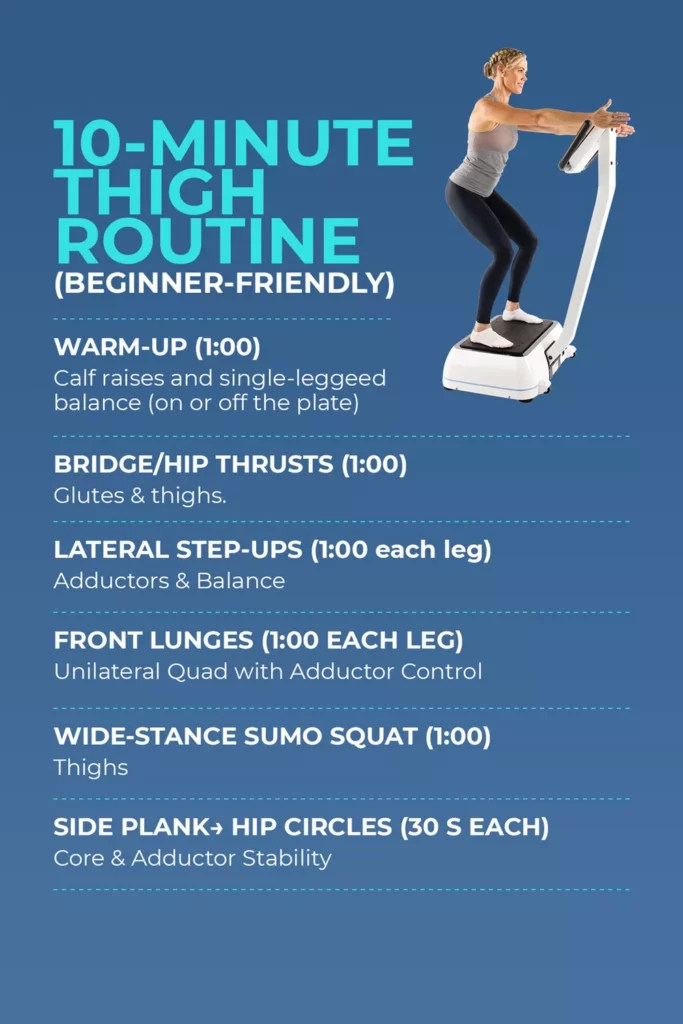
Infographic titled 10-Minute Thigh Routine (Beginner-Friendly) with illustrated woman on a vibration plate and step-by-step exercise guide
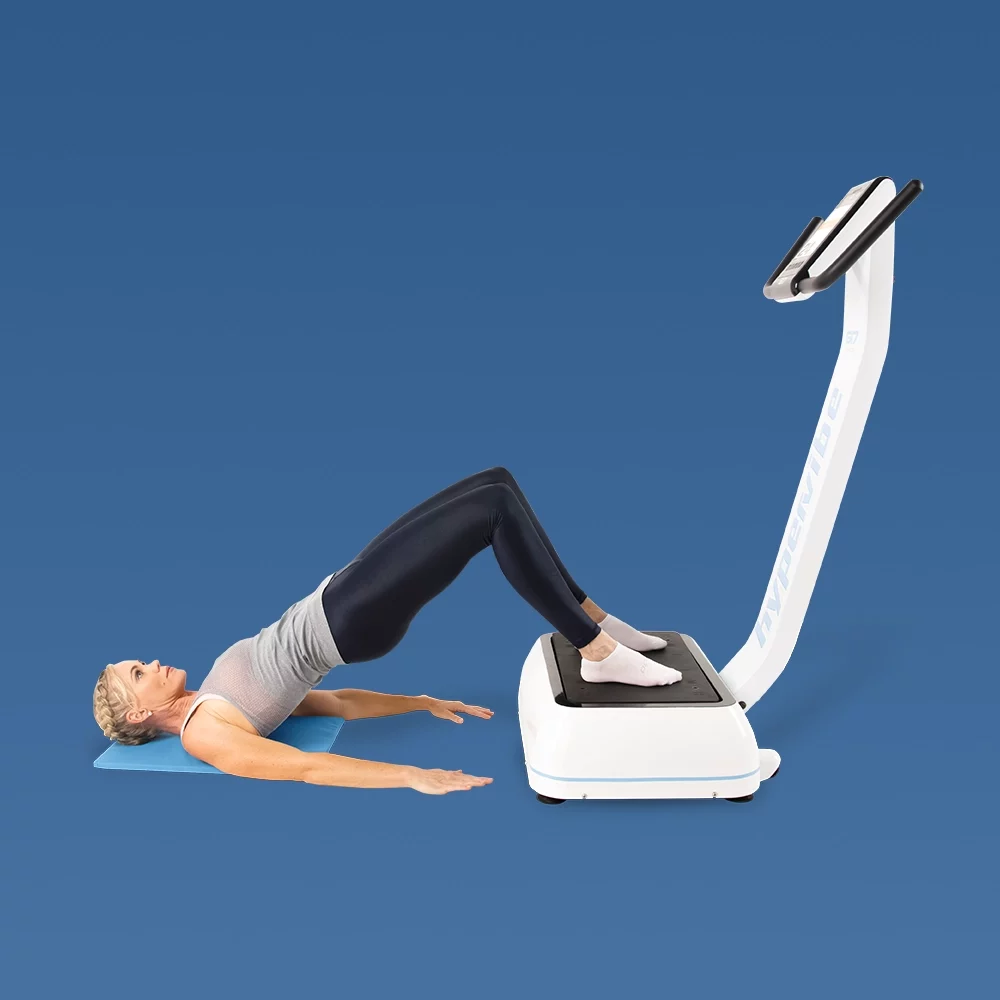
Woman doing hip thrusts on Hypervibe vibration platform
Avoid overarching your lower back; keep your core engaged.
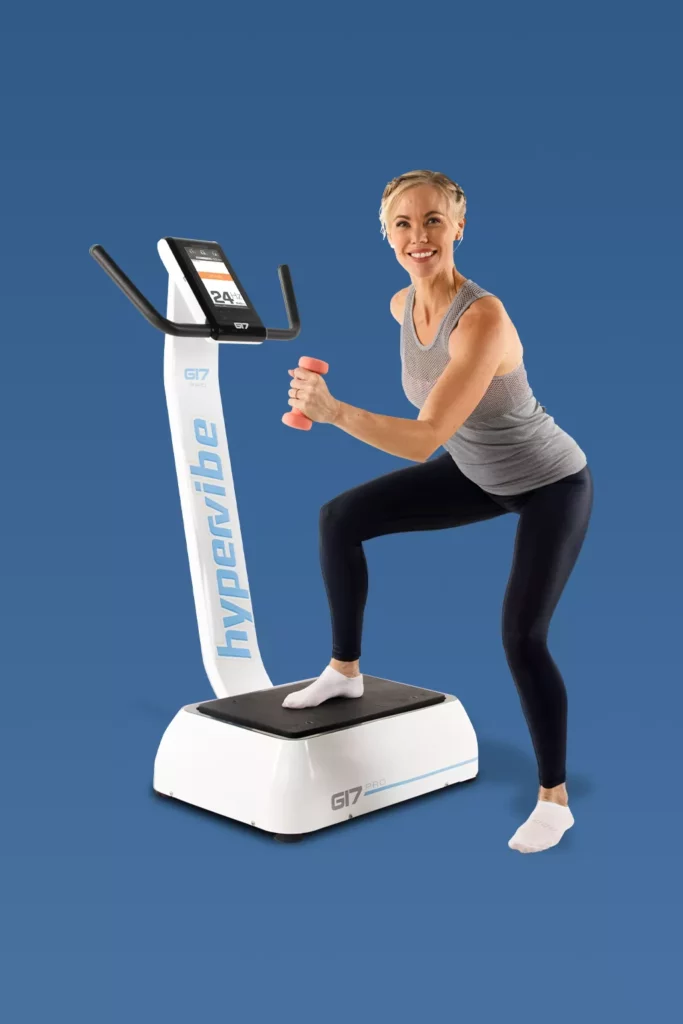
Fit woman performing lateral step-up on aerobic step platform
Keep the knee tracking over toes (don’t let it collapse inward). Use the Vibration Plate tower for balance if needed.
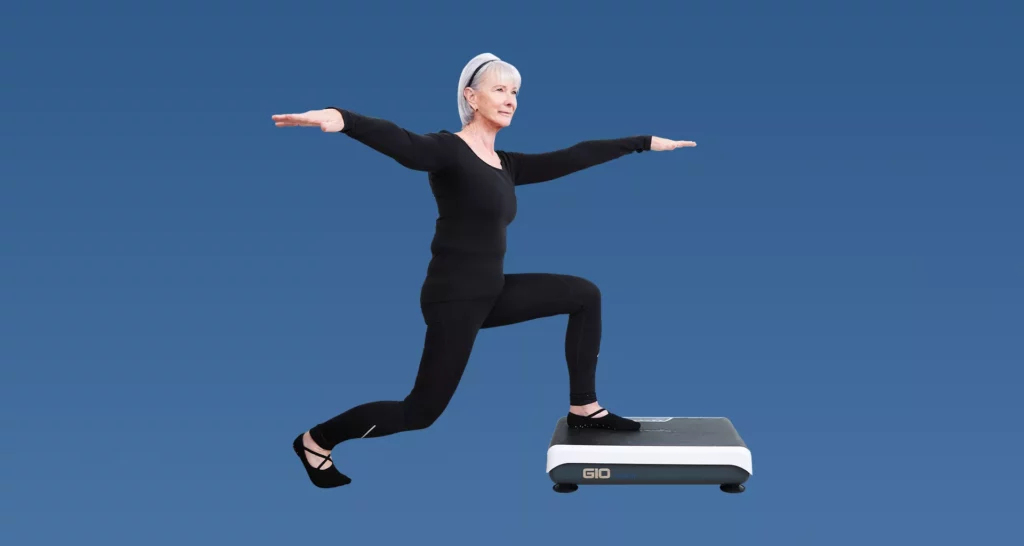
Older woman performing a front lunge on a hypervibe vibration platform
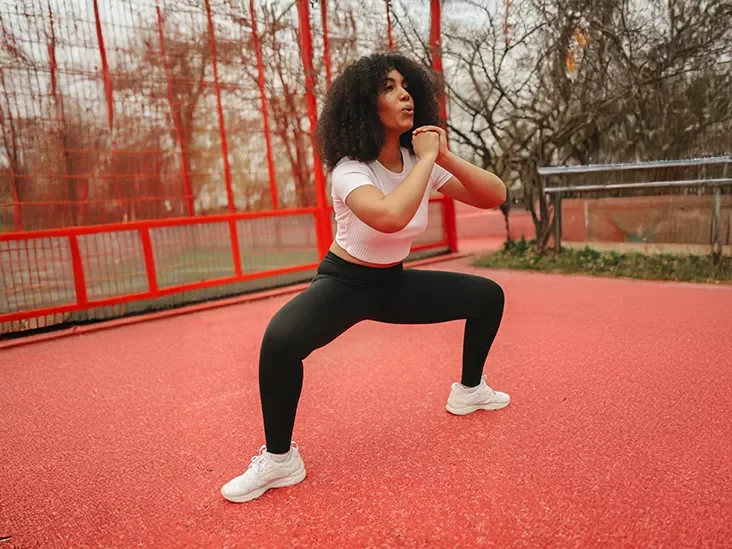
woman doing wide-stance sumo squat with a kettle weight
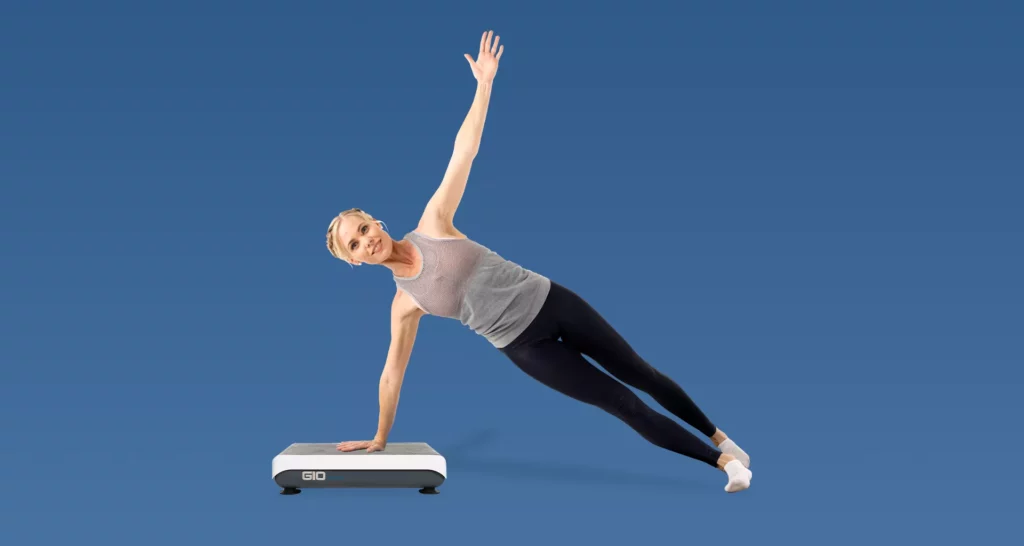
Fit woman doing a side plank on a Hypervibe G10 Platform
Move A (30 s): Side plank with upper foot on the plate and elbow on floor → 8–12 Hz
Move B (30 s): Standing hip circles → 12–15 Hz (stand with one leg near the center of the plate and make slow circles with the opposite leg).
Cue:
To build consistency and strength with your Vibration Plate thigh exercises, follow this simple four-week schedule.
|
Week |
Sessions/wk |
Time/session |
Hz goal |
Notes |
|
1 |
2 – 3 |
10 -20 min |
8 → 12 Hz |
Learn movement patterns. Use lower settings if joints are sensitive. |
|
2 |
3 – 4 |
10 – 20 min |
12 → 15 Hz |
Add 2 minutes. Hold moves slightly longer |
|
3 |
3 – 4 |
10 – 20 min |
15 → 18 Hz |
Increase time-under-tension (longer holds). |
|
4 |
4 |
10 – 20 min |
18 → 24 Hz |
Higher g-forces only with clean form and minimal joint soreness. |
Measure improvement with 2–3 simple markers:
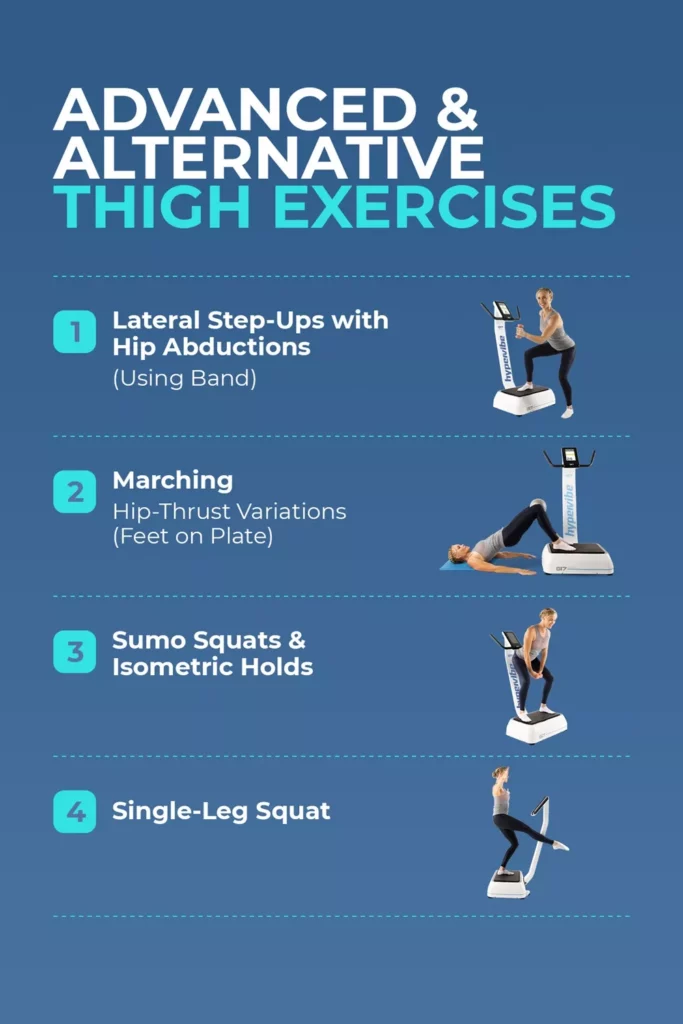
Infographic titled Advanced & Alternative Thigh Exercises with four illustrated movements.
The more you exercise, the more you can handle increasing exercise difficulty levels.
Also, the greater your exercise endurance becomes.
Here are more advanced moves:
Loop a resistance band around your knees. Follow the same format as above, maintaining tension against the band.
Perform 8–12 slow reps on each side at 18–22 Hz.
Cues: Keep stance hip-width for balance, toes forward for knee alignment, and amplitude 2-4 mm for controlled activation.
Lie on your back with feet flat on the plate and lift into a bridge.
Then, march in place, keeping one leg under tension on the plate as the other one lifts up.
Perform 10 slow reps on each side at 15-18 Hz. Amplitude at 2-4 mm for controlled activation.
Cues: Squeeze glutes tightly while keeping spine neutral and core engaged. Press through the heel.
Stand with feet wider than shoulder width, toes turned out 25–35°.
Squat to a comfortable depth and hold or perform slow reps at 15-22 Hz.
Cues: Wide stance to bias adductors, toes angled outward for thigh recruitment.
Start at amplitude 2 mm and progress gradually to 3–4 mm (as long as feet are stable).
Standing on one leg, slowly drop into a one-legged squat.
Return to start.
Use support if needed (chair or tower).
Perform 6–10 reps per side at 12–24 Hz.
Cues: Keep knee tracking over foot. Amplitude 4-6 mm for strong activation.
Use compound moves like sumo squats and lateral step ups with shorter rest periods (20–40 s) to increase metabolic demand.
Stick to amplitudes of 1–2 mm, use chair or wall support, and stay at lower frequencies (8–12 Hz).
Exercises such as lateral lunges, sumo holds, and banded abductions directly recruit the thigh muscles.
Infographic titled Integrating Cardio, Strength & Nutrition for Stronger & Slimmer Thighs with icons for cardio, strength, protein, hydration, and sleep, each paired with
To get leaner, stronger thighs, you need a three-part approach:
WBV exercises work best as part of a complete program—not as a standalone fat-loss solution.
Aim for 30 minutes of moderate cardio (brisk walking, elliptical, jogging, or cycling) 2–3× per week, in addition to your WBV sessions.
Include resistance training (WBV + bodyweight or loaded moves) 2–3× per week.
This preserves lean mass during a calorie deficit and helps the thighs look firmer as fat is reduced.
Target 20–40 g of high-quality protein at your main meals or within a couple of hours of training.
This supports muscle repair and adaptation.
Easy post-WBV snack ideas:
Stay hydrated throughout the day.
For moderate workouts of about 1 hour, plan to consume around 24 oz (700 mL) of fluid during and after activity.
Adjust for heat or heavy sweating. Proper hydration supports:
Aim for 7–9 hours per night. Quality sleep enhances recovery, appetite regulation, and training gains.
If you’re busy and always on the go, stack habits for consistency:
Short, frequent sessions are more effective than infrequent long ones—and consistency is the true driver of results.
Whole Body Vibration (WBV) is generally safe when used correctly, but it may not be suitable for everyone.
Consult your doctor if you have any of the following conditions:
|
Level |
Frequency (Hz) |
Amplitude (mm) |
G-Force |
|
Beginner |
8–12 |
1–2 |
Low G |
|
Intermediate |
12–18 |
2–4 |
Low-Medium G |
|
Advanced |
18+ |
4–6 |
Medium-High G |
Note: Some amplitudes may differ based on the position required for the exercise.
Yes, they can—especially when paired with targeted moves like sumo squats, lateral lunges/step ups, and bridges that boost adductor activation.
Together, these exercises enhance neuromuscular contractions, helping your muscles work more efficiently during movement.
For best results, include a balanced diet with adequate protein in your routine.
Remember: Fat-loss timelines depend heavily on consistency and calorie balance.
Always increase gradually and follow your Vibration Platform’s recommended ranges.
Yes, you can.
If pain is sharp or persistent, stop and consult a clinician.
Not always.
If you’re a beginner or have foot/joint concerns, start with shoes and lower Hz settings.
Vibration machines do not all deliver the same results.
Factors such as frequency range, G-force, and platform design play a big role in the results you want.
For exercises that target slimmer thighs, two things determine how much your muscles work:
Hypervibe machines offer the perfect balance between these two.
This balance is what yields faster results from exercises like squats, leg presses, or thigh pulses on the plate.
And it goes beyond just hardware because we also offer resources designed to keep you consistent and supported, so you don’t have to wing it or make assumptions.
We provide:
We also carry medical certifications and provide clear safety guidance.
Safe, consistent Vibration Plate exercises can make a noticeable difference when you want slimmer, stronger thighs—especially when paired with regular cardio and a balanced diet.
Start small, let your body adjust (and listen to it), and you may be surprised at how quickly your thighs begin to feel more toned and powerful.
If you’re tired of guessing and want to find the best vibration plate exercises that fit your lifestyle, book a quick call with one of our product specialists. You can also download our free Hypervibe Buyer’s Guide.
Toning your thighs doesn’t have to be complicated. Just a few minutes of consistent Vibration Plate training can help you feel leaner, stronger, and more confident.
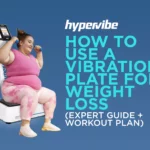
Here’s how we use a vibration plate for weight loss...
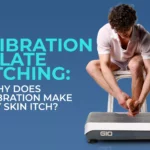
Many people, especially beginners, notice an itchy or tingling “pins-and-needles”...

Taking into consideration the growing popularity of the vibration plate,...

The lymphatic system, also called the lymphoid system, is an...
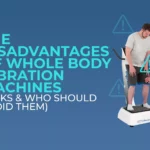
Are vibration machines bad for you? Yes, if used incorrectly....